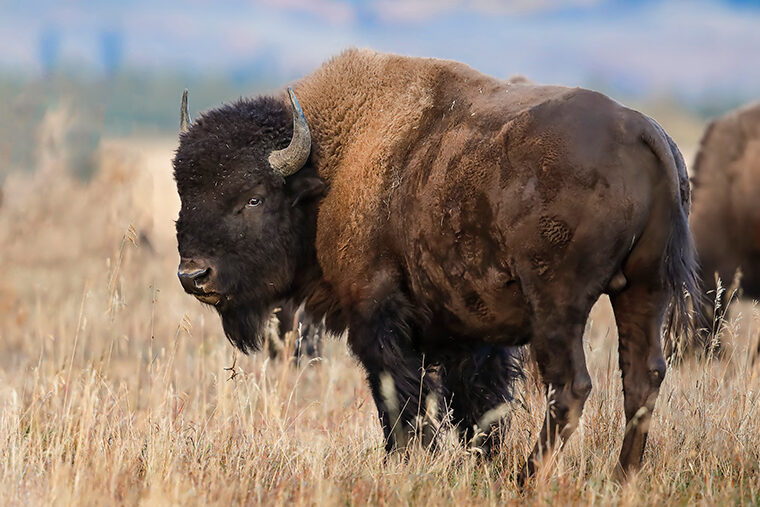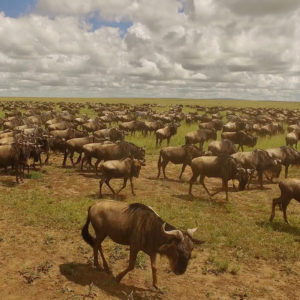About 5,000 to 7,000 years ago, in river valleys and grasslands all around the world, people started to cultivate small plants for their seed or grain. Wheat, barley and rice are some of the earliest plants to show signs of domestication, and scientists have extensively studied the domestication process in these large-seeded cereal crops. Significantly less is known about the domestication of small-seeded grain crops — such as quinoa, amaranth, buckwheat, the millets and several now-lost crops domesticated in North America.
A study published July 8 in the journal Nature Plants presents a novel model for how small-seeded plants came to the table — and it relies on help from large, grazing animals, including bison. The new work is a collaboration between Natalie Mueller, assistant professor of anthropology in Arts & Sciences at Washington University in St. Louis, and Robert Spengler, director of the Paleoethnobotany Laboratories at the Max Planck Institute for the Science of Human History.
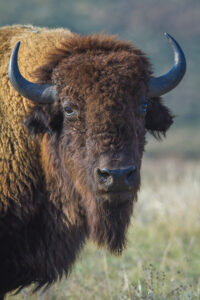
“As ecosystem engineers, bison have been hiding in plain sight for the past 40 years, since archaeologists first discovered that several native plants were domesticated in eastern North America and started to theorize about how and why,” Mueller said.
“I think the reason no one has thought of them before is because they were almost driven to extinction, along with the tall grass prairies where the lost crops were domesticated,” she said. “As a result, very few of us have ever seen a tall grass prairie with bison grazing on it, much less spent time walking through one and gathering food.”
Mueller and Spengler have been interested in plant domestication since they were graduate students together at Washington University, under Gayle Fritz, now an emeritus professor of anthropology and one of the first scholars to recognize the importance of the American Midwest as a center of crop domestication.
Despite decades of research into the nature of plant domestication in North America, no one has considered the role that bison herds may have played until now. The plants that were domesticated, what Mueller calls the “Lost Crops,” would have been dispersed by bison in large swaths, making them easy to collect by ancient people and perhaps encouraging these communities to actively plant them themselves. When Europeans exterminated the herds, the plants that relied on these animals to disperse their seeds began to diminish as well. Because the wild ancestors of these lost crops are rare today and the bison herds are effectively extinct, researchers have overlooked this important coevolutionary feature in the domestication process.
However, this process is not unique to the American Midwest, and the researchers suggest that there may be links between buckwheat domestication and yak herding in the Himalaya, and amaranth domestication and llama herding in the Andes. The authors have identified parallel patterns in rangeland ecology studies, noting that heavy herd animal herbivory can homogenize vegetation communities. For example, heavy pastoralist grazing in the mountains of Central Asia causes many plants to die, but certain plants with adaptations for dispersal by animals thrive. The depositing of plant seeds in nutrient rich dung leads to ecological patches, often called hot spots, that foragers can easily target for seed collecting.
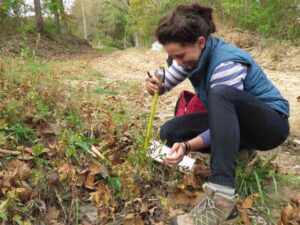
Mueller is now working at a restored tall grass prairie in Oklahoma, where conservators from The Nature Conservancy have been investigating the ecological effects of bison grazing and fire since the mid-1990s. Parts of the prairie are fenced off to exclude the bison. This makes it an ideal location for Mueller to see what effect the bison have on crop progenitors.
“On my first visit to the Tallgrass Prairie Preserve, it was immediately apparent that bison are at the very least creating habitat for three crop progenitors. These three species occurred together in dense stands in bison traces and wallows, and are mostly absent in the bison exclusion areas, just as we predicted,” Mueller said.
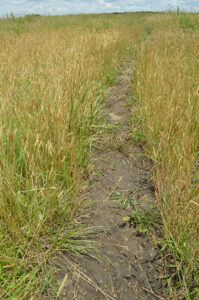
“Even more striking was the effect the bison have on the landscape in terms of the embodied experience of a human,” she said. “Ungrazed tallgrass prairie is treacherous — snakes! — disorienting, and difficult to move through. It also has very little food in the form of seeds, because there are (fewer) annual plants.”
“Within the grazed prairie, it was natural, easy and more safe to follow the bison trails through the prairie, and when we did we found ourselves walking through large clearings full of lost crop progenitors and ending up at water sources — win, win, win,” Mueller said.
Mueller is also collecting dung during her visits to the prairie. The dung is currently on a mist bench in a greenhouse at Washington University, where Mueller is watching to see what seeds will germinate from it. Mueller and Spengler also are seeking collaborators for a controlled feeding study. They plan to feed the seeds of crop progenitors to bison, then collect their dung and see how many seeds made it through their digestive system — and how many subsequently germinate.
“Archaeologists who work in eastern North America will need some convincing that bison were a significant factor in shaping early agricultural landscapes,” Mueller said. “But when you see the way bison transform the prairie in person, it’s hard to believe we didn’t think of it before.”
